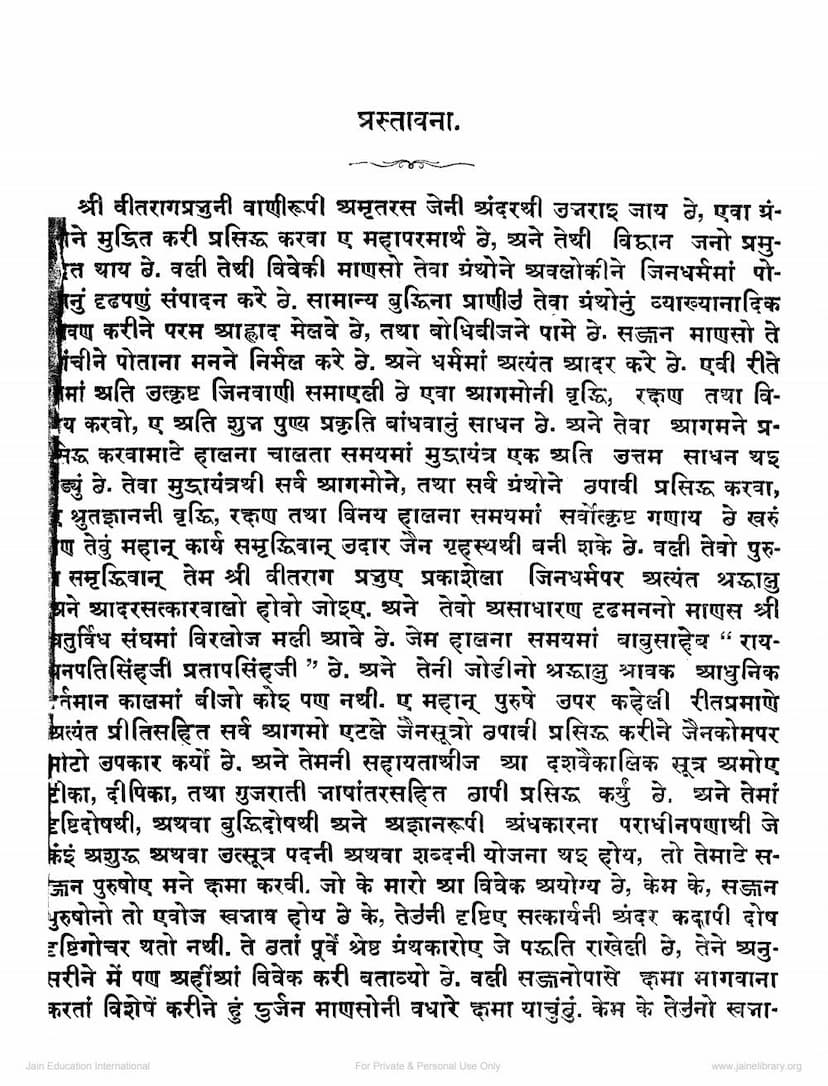Agam 42 Mool 03 Dashvaikalik Sutra
Added to library: September 1, 2025

Summary
This Jain text, "Agam 42 Mool 03 Dashvaikalik Sutra" authored by Darbarilal Nyayatirth and published by Manikchand Digambar Jain Granthamala Samiti, is a significant Jain scripture. The provided text contains a detailed introduction and the beginning of the first chapter (Chapter 1: Mangalacharana) of the Dashvaikalik Sutra, along with commentaries (Tika, Avachuri, Deepika).
Here's a breakdown of the comprehensive summary in English:
Book Title: Agam 42 Mool 03 Dashvaikalik Sutra Author: Darbarilal Nyayatirth Publisher: Manikchand Digambar Jain Granthamala Samiti
Overall Purpose and Significance:
The introduction (Prastavna) of the text highlights the profound importance of the Agamas (Jain scriptures) as the repository of the teachings of Lord Mahavir (Shri Vitaraag Prabhu). The publication and dissemination of these texts are considered a great philanthropic act that benefits scholars, guides the virtuous, strengthens faith in Jainism, and provides spiritual guidance and joy to ordinary people. The text emphasizes the role of modern printing technology in spreading these invaluable scriptures and expresses gratitude to the generous individuals who support such endeavors.
Key Themes and Content:
-
The Glory of Jinavani (Jain Scriptures): The introduction elaborates on the merits of studying and propagating Jain scriptures, stating that they are a source of nectar-like ambrosia, enlightening the wise, strengthening the faith of the discerning, bringing joy and spiritual seeds to those with ordinary intellect, and purifying the minds of the virtuous. It underscores the immense spiritual merit in the propagation and protection of these Agamas.
-
The Generosity of Patrons: The text expresses deep gratitude towards the liberal and devout Jain householders, specifically mentioning "Babusaheb Rai Dhanpat Singhji Bahadurbahadurpur" and his equally devoted wife, as unparalleled patrons in the modern era. Their contribution has enabled the publication of the Dashvaikalik Sutra with commentaries, explanations, and Gujarati translations.
-
Origin of the Dashvaikalik Sutra: A significant portion of the introduction is dedicated to narrating the origin of the Dashvaikalik Sutra. It recounts the story of Acharya Shyayambhavya Swami, who, after taking diksha, learned that his wife was pregnant. His wife later gave birth to a son named "Manak." When Manak grew up and learned about his father, he sought him out. Acharya Shyayambhavya, recognizing Manak's destiny and limited lifespan, composed the Dashvaikalik Sutra, comprising ten chapters (studies), drawing from the vastness of the ancient scriptures (Purvas). This teaching helped Manak attain liberation within his remaining lifespan. The ten chapters are known as "Dashvaikalik" because they are relevant during all ten periods of the day. The two concluding parts (Chulikas) were also sent by Lord Shrimandhar Swami.
-
Importance for Ascetics: The Dashvaikalik Sutra is highlighted as essential for monks (sadhus) to understand and remember, as it helps them avoid transgressing their vows and committing errors in their conduct.
-
Commentaries and Translations: The text mentions the commentaries available on the Dashvaikalik Sutra:
- "Shishyabodhinī" and "Avachuri" by Acharya Harisuri Suriji, the author of 1444 commentaries.
- "Dīpikā" by Acharya Samaysundar Ganin, a disciple of Acharya Sakalchandra Ganin of the Kharatara Gaccha. The current publication includes these commentaries along with the original Gujarati translation and the complete text of the Dashvaikalik Sutra.
-
Apology for Errors: The author, Darbarilal Nyayatirth, humbly requests forgiveness from learned and virtuous readers for any errors in the text, attributing them to potential defects in vision, understanding, or the darkness of ignorance.
-
List of Chapters (Anukramanika): The index provides a clear outline of the ten chapters of the Dashvaikalik Sutra and the two Chulikas:
- Chapter 1: Mangalacharana
- Chapter 2: Drumapushpika
- Chapter 3: Shravanya Purva
- Chapter 4: Dukha-achara
- Chapter 5: Shat-jivanika
- Chapter 6: Pindaeshana (Part 1 & 2)
- Chapter 7: Mahacharya Katha
- Chapter 8: Vakya Shuddhi
- Chapter 9: Achara Pranidhi
- Chapter 10: Vinaya Samadhi (Parts 1-4)
- Chapter 11: Shuka Nama
- Dashvaikalik: First Chulika
- Dashvaikalik: Second Chulika
- Dashvaikalik: Mool Sutra Path
-
Invocation (Mangalacharan): The text begins with an invocation, "Om Namo Vitragaya," followed by the first verse, "Dhammo Mangalamukkam, Ahimsa Sanjamo Tavo | Deva Vih Tam Namasanti, Jassa Dhamme Sada Mano || 1 ||" This verse praises Dharma (Righteousness) as the highest auspiciousness, highlighting non-violence (Ahimsa), self-control (Sanjama), and austerity (Tapa) as its core components. It states that even gods bow to the one whose mind is always devoted to Dharma.
-
Explanation of the First Verse (Mangalacharan): The text then proceeds to explain the meaning of this foundational verse, elaborating on the concepts of Dharma, Ahimsa, Sanjama, and Tapas, and why Dharma is considered the ultimate auspiciousness. It draws parallels with the divine garland makers and emphasizes that Dharma is eternally auspicious, offering protection and guidance.
Commentaries Explained:
- Avachuri: This seems to be a simpler, more accessible explanation of the verses.
- Deepika: This commentary likely offers a more detailed and nuanced explanation of the verses, possibly delving into the philosophical and etymological aspects.
- Tika: This is a critical or elaborate commentary, likely providing scholarly analysis, scriptural references, and historical context.
Overall Impression:
The text is presented as a sacred and profound compilation of Jain teachings, emphasizing practical conduct and spiritual discipline for monks. The inclusion of detailed commentaries and the historical narrative of the scripture's origin highlight its reverence and the effort taken to make its wisdom accessible. The initial pages set a devotional tone and underscore the importance of preserving and disseminating these ancient teachings.